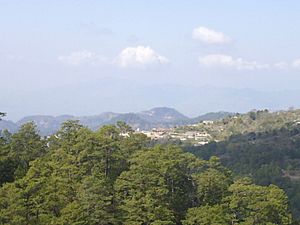Gualcince facts for kids
Gualcince (pronounced gwal-SIN-seh) is a small town and a municipality in the Honduran region of Lempira. It's a part of the Lempira department, which is a larger area in Honduras. Gualcince is about 78 kilometers (about 48 miles) away from the city of Gracias. To get there, you usually pass through San Juan, Intibuca, and then through the towns of Santa Cruz and San Andrés. The roads leading to Gualcince are often being fixed, and some parts can be narrow.
Contents
History of Gualcince
Gualcince was first known as "Gualán." We don't have an exact date for when it was founded. However, old records show that the main Catholic Church in the town was built way back in 1576. This means the area has been settled for a very long time!
In a census from 1791, Gualcince was important enough to be the main town of the "Cerquin" area. Later, in 1889, when the country was divided into different regions, Gualcince was listed as one of the towns in the Candelaria district. It officially became its own municipality in 1840.
Where is Gualcince?
Gualcince is located in a beautiful area with many large mountains. These mountains are covered with thick pine forests. One of the most famous mountains is called "Congolon." The mountain environment is great for growing coffee. It also provides many natural water springs.
Gualcince's Neighbors
Gualcince shares its borders with several other towns and areas:
- To the North: San Andrés and Erandique municipalities.
- To the South: Mapulaca and Candelaria municipalities.
- To the East: Piraera municipality.
- To the West: La Virtud municipality.
The total area of Gualcince municipality is about 163 square kilometers (about 63 square miles).
What People Do in Gualcince
The main way people in Gualcince make a living is by growing coffee. The mountains and climate are perfect for coffee plants. Besides coffee, people also grow corn and beans, which are important foods in Honduras.
Raising cattle (like cows) is mostly done for local families to use. Vegetables are not grown much in Gualcince. So, they are often brought in from other towns or even from other parts of Honduras, like the Intibuca region.
Who Lives in Gualcince?
In Gualcince, the population is a mix of different backgrounds. About half of the people are descendants of both Spanish settlers and native Indian groups. The other half are mainly descendants of the original native Indian people who lived there.
According to a census in 2013, Gualcince municipality had about 11,295 people. Most of the people (around 73.69%) are Indigenous (native people). About 20.64% are Mestizo (a mix of European and Indigenous heritage). There are also smaller groups of Black or Afro-Honduran people and White people.
Gualcince municipality has 12 main villages and 103 smaller settlements where people live.
Visiting Gualcince
Gualcince offers amazing views of tall, steep mountains covered in pine trees. You can also see very old buildings, like the historic Catholic Church and some houses that are still lived in today.
While Gualcince doesn't have hotels, the nearby town of Candelaria is only about 40 minutes away and might have places to stay. There are grocery stores in Gualcince, which makes it easy to visit for a while. A popular local dish to try is "Pupusas de Flor de Oroco."
The main local holiday in Gualcince is on December 8th. This day celebrates "Inmaculapa Concepcion" (the Immaculate Conception).
Gallery
See also
 In Spanish: Gualcince para niños
In Spanish: Gualcince para niños








